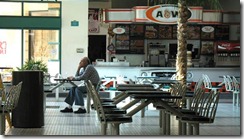Greg Lindsay’s blog for Fast Company recently was an excellent overview of how and why malls became so standardized and the impact on the sense of place in some communities.
Durham is fortunate that when the company formerly know as Urban developed The Streets at Southpoint here, it took a very innovative approach and tried its best to tie the mall in to Durham’s look through extensive brickwork, chimney’s and faux retro outdoor signs.
Durham is also fortunate that its first mall of this type, Northgate, is still owned and continually updated by a local family that remains dedicated to the community. They are often handicapped by a mall or two in a community to the east and south that has routinely required leases forbidding a store in Durham and greatly misleading national tenants with misperceptions that the region is centric when it is very polycentric with no dominant center, requiring two if not three or four stores of a type.
Northgate has also been handicapped by demo maps that show nearby Duke University as a black hole, when in reality it is one of the largest employers in North Carolina. Kudos to Northgate for fighting through this BS. When Durhamites assert that there is simply no such place as Raleigh-Durham (the truncated name of a co-owned airport,) remember you’re being loyal to local families like the one that owns Northgate.
Durham is also a leader in urban gardening and enthusiasts might be interested in a Fast Company blog today about adaptive reuse of part of a Cleveland mall for that purpose.

No comments:
Post a Comment